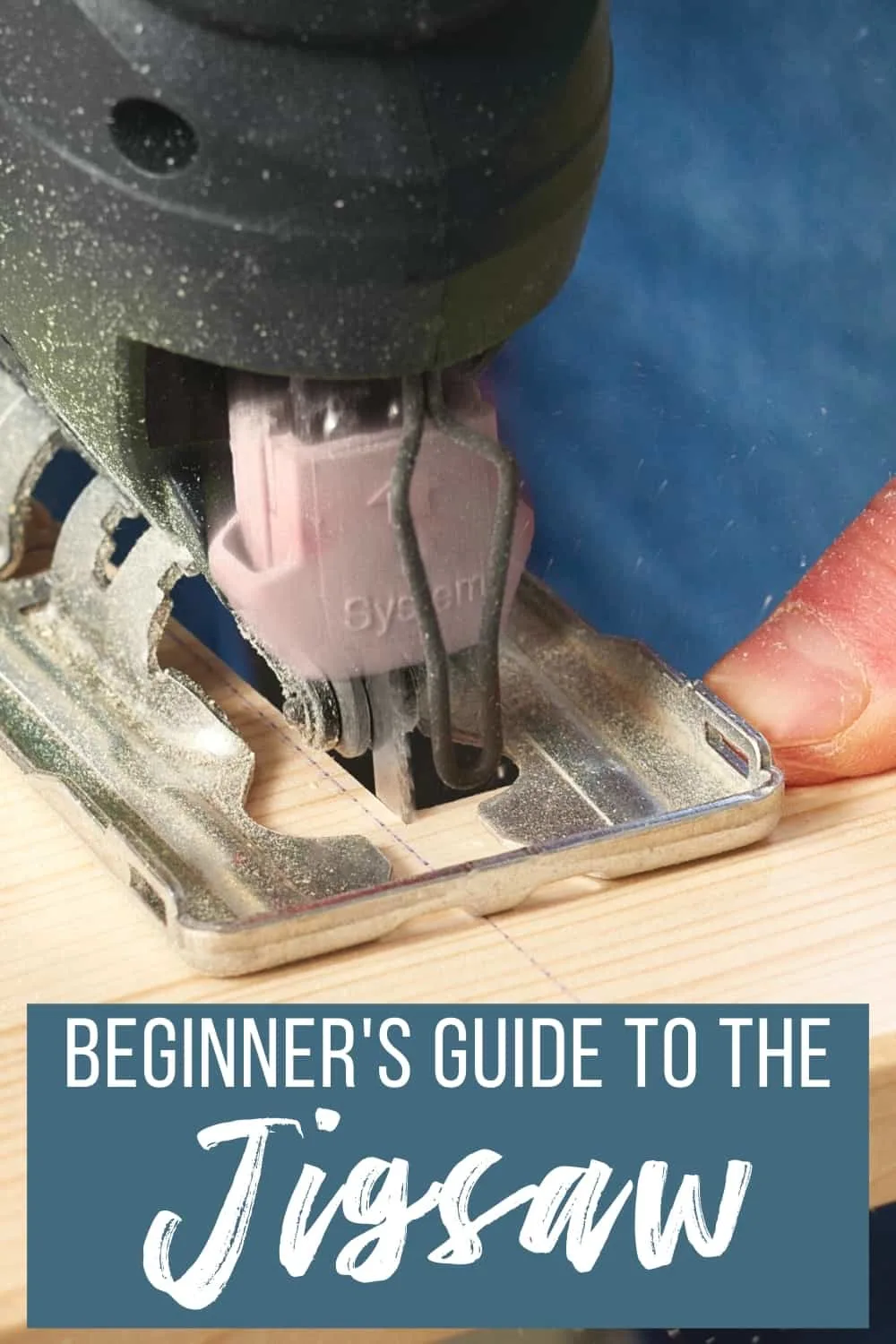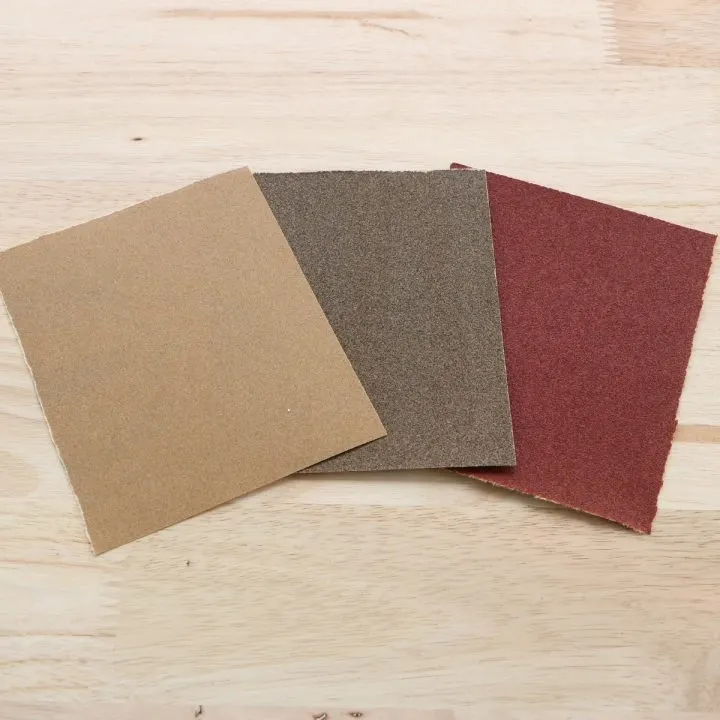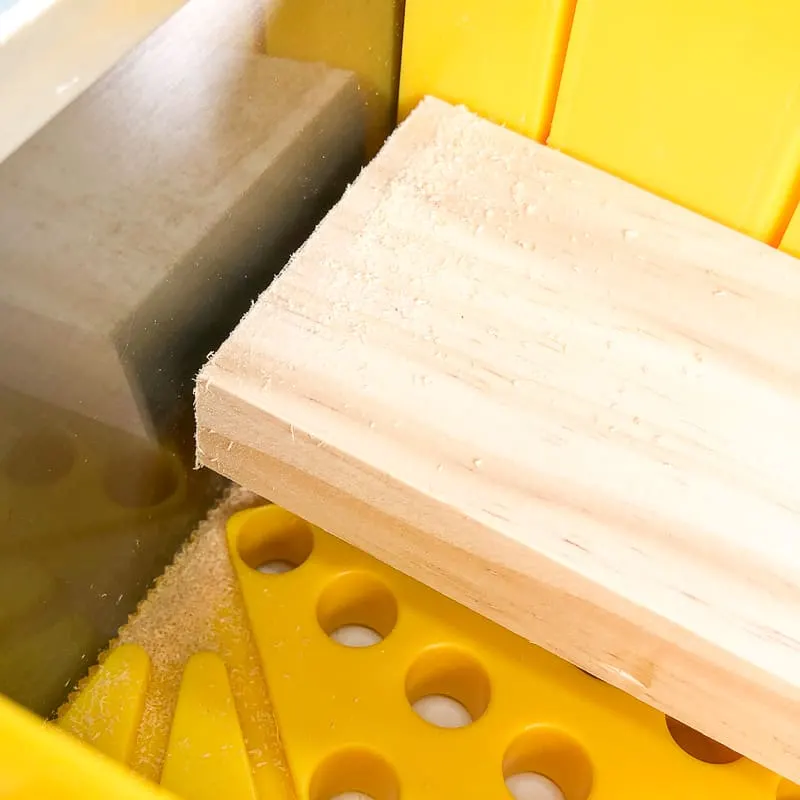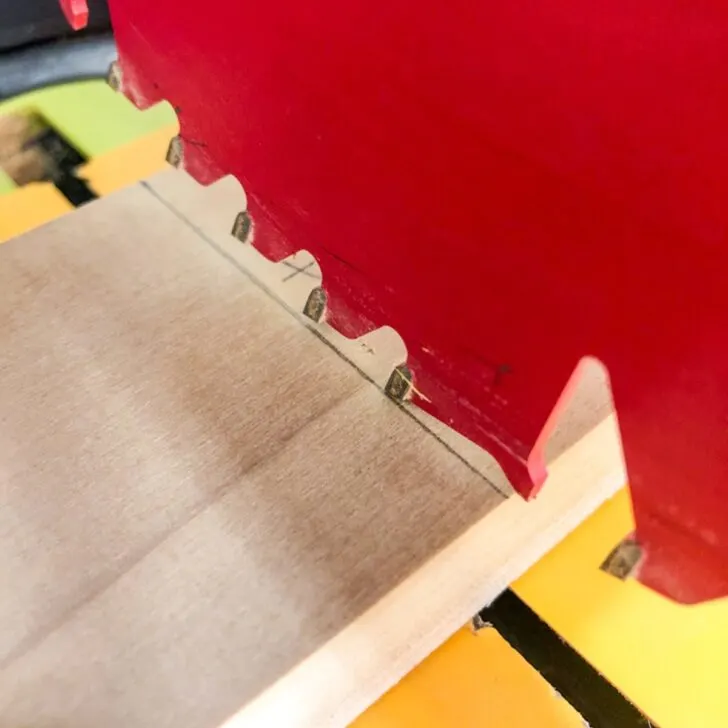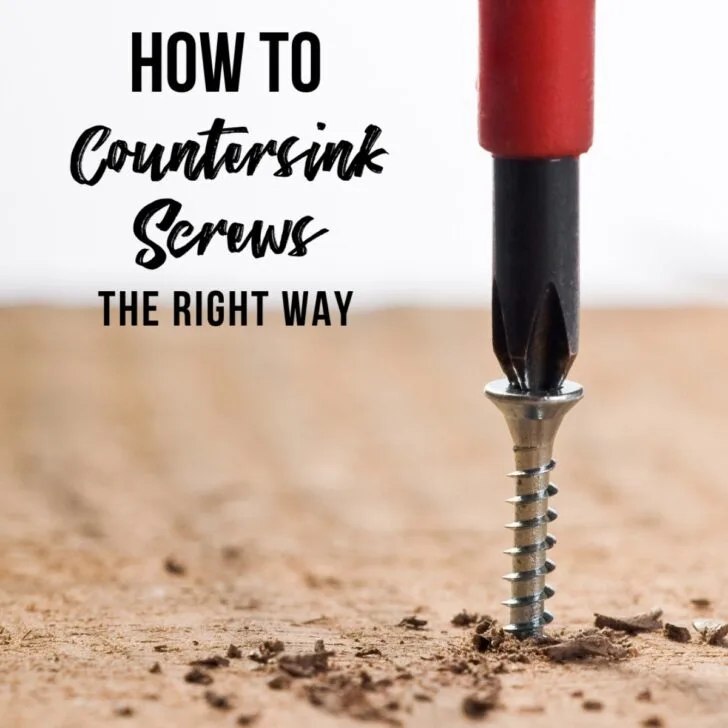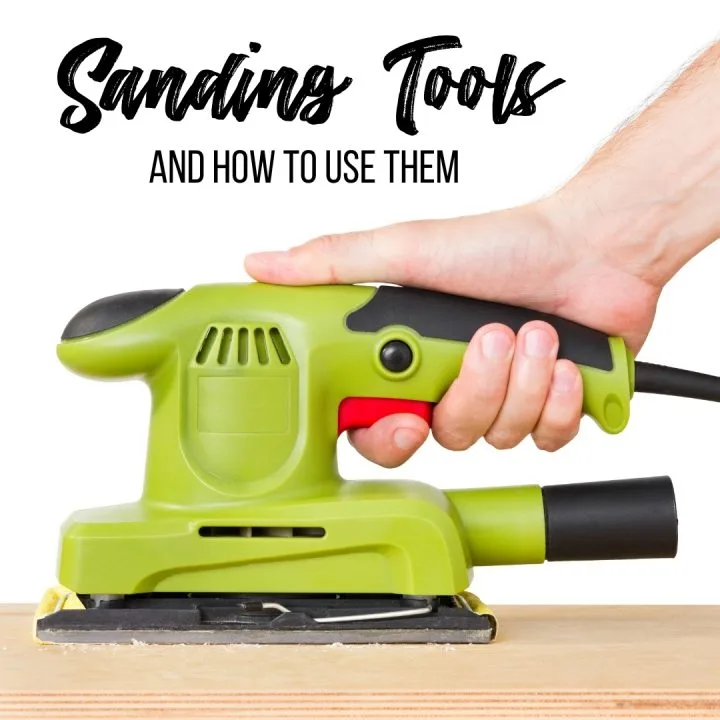The jigsaw is a versatile tool that should be in every garage! Learn how to use a jigsaw, including straight cuts and curves, in this article!
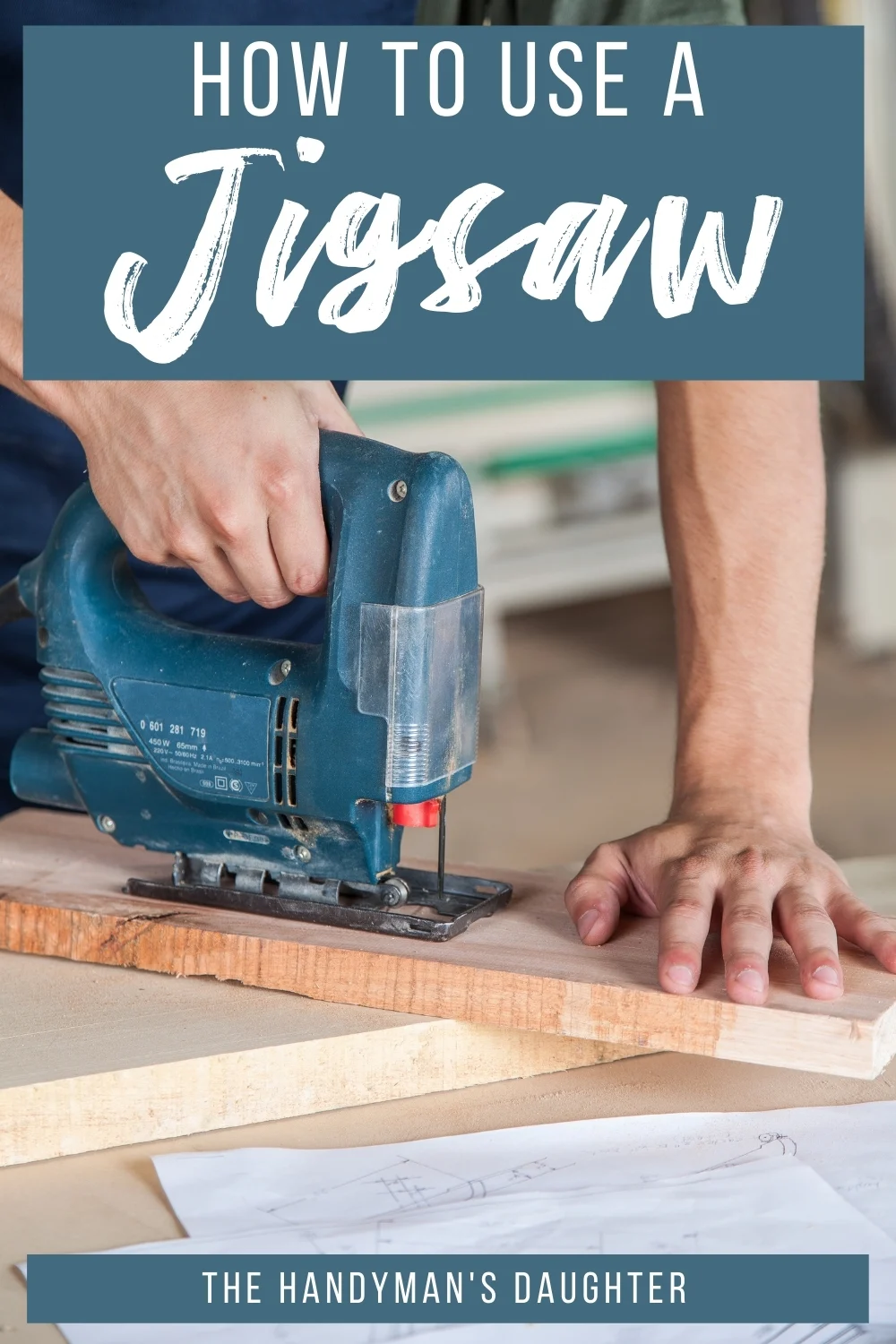
If I could choose one saw that should be in every homeowner's toolbox, it would be the jigsaw. It's one of the safest power tools available, making it perfect for a beginner. It's capable of making a variety of different cuts in a wide range of materials, including bevels and curves. It is not the perfect saw for every project, but there are times when only a jigsaw will do the trick!
This post contains affiliate links for your convenience. Purchases made through these links may earn me a small commission at no additional cost to you. Please visit my disclosures page for more information.
What is a Jigsaw?
A jigsaw is a powered handheld saw that cuts material using a thin, straight blade that moves up and down. The jigsaw is also known as a sabre saw, and is a portable version of a scroll saw.
What is a Jigsaw Used For?
Jigsaws have a wide range of uses. With a jigsaw, you can make straight cuts, beveled cuts, and (with practice) plunge cuts.
However, where the jigsaw shines is curved cuts, like circles, arches and more intricate designs. The jigsaw's ability to cut tight curves and angles makes it similar to the bandsaw and the scroll saw.
I've used a jigsaw for countless projects over the years, from a rocket bookshelf to a wooden Christmas tree! It's my go-to tool whenever I need to cut a circle in wood that's bigger than a hole saw can handle, like the 6" diameter hole in this cornhole board.
Parts of a Jigsaw
Before we start learning how to use a jigsaw, you should first know all the different parts and what they do.
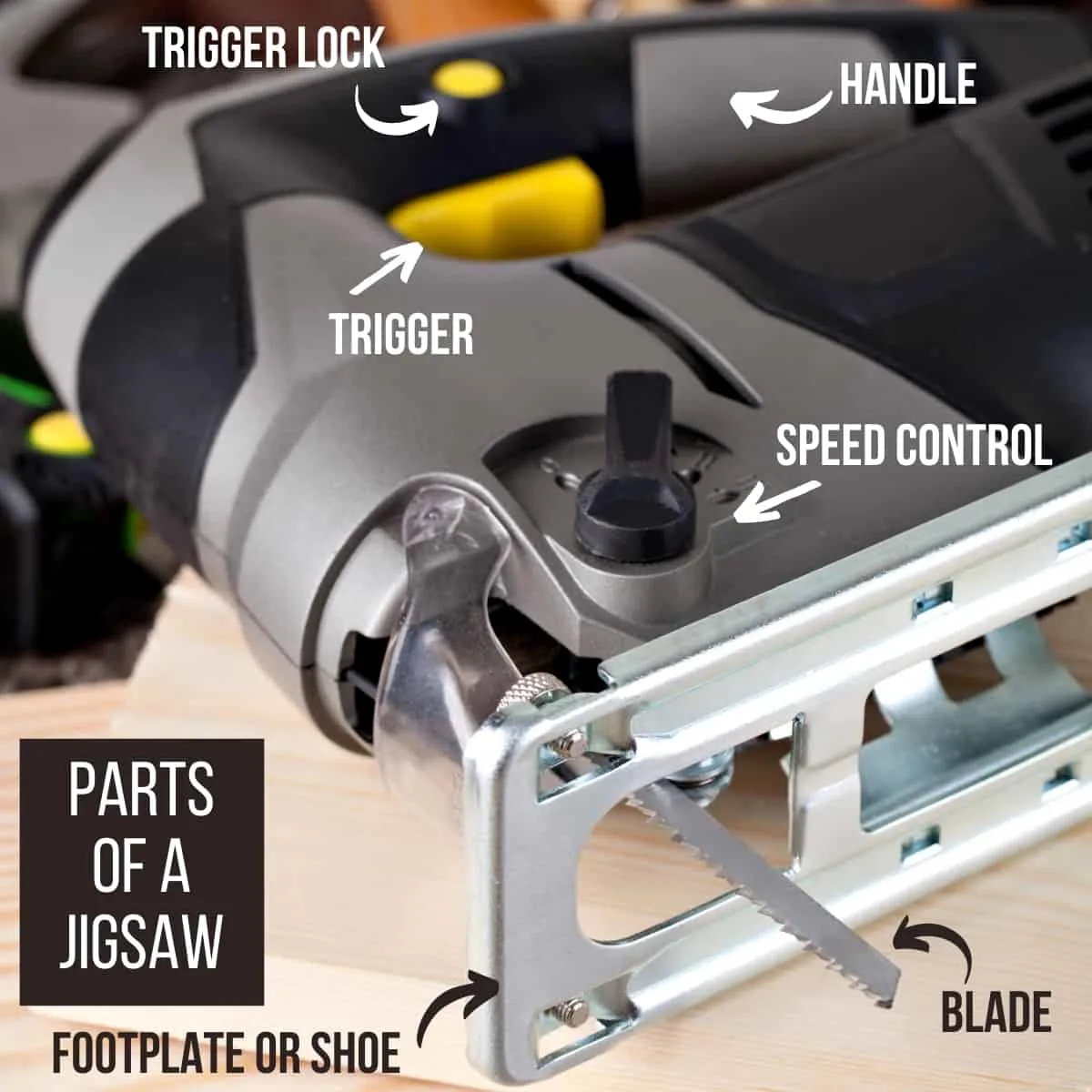
Handle
There are two different jigsaw handle styles: bow handle, which can also be called "D handle" and barrel grip.
On a D handle jigsaw, the handle sits up on top of the saw and can easily be used one-handed. This is the more traditional style of the two, and you have probably seen one before.
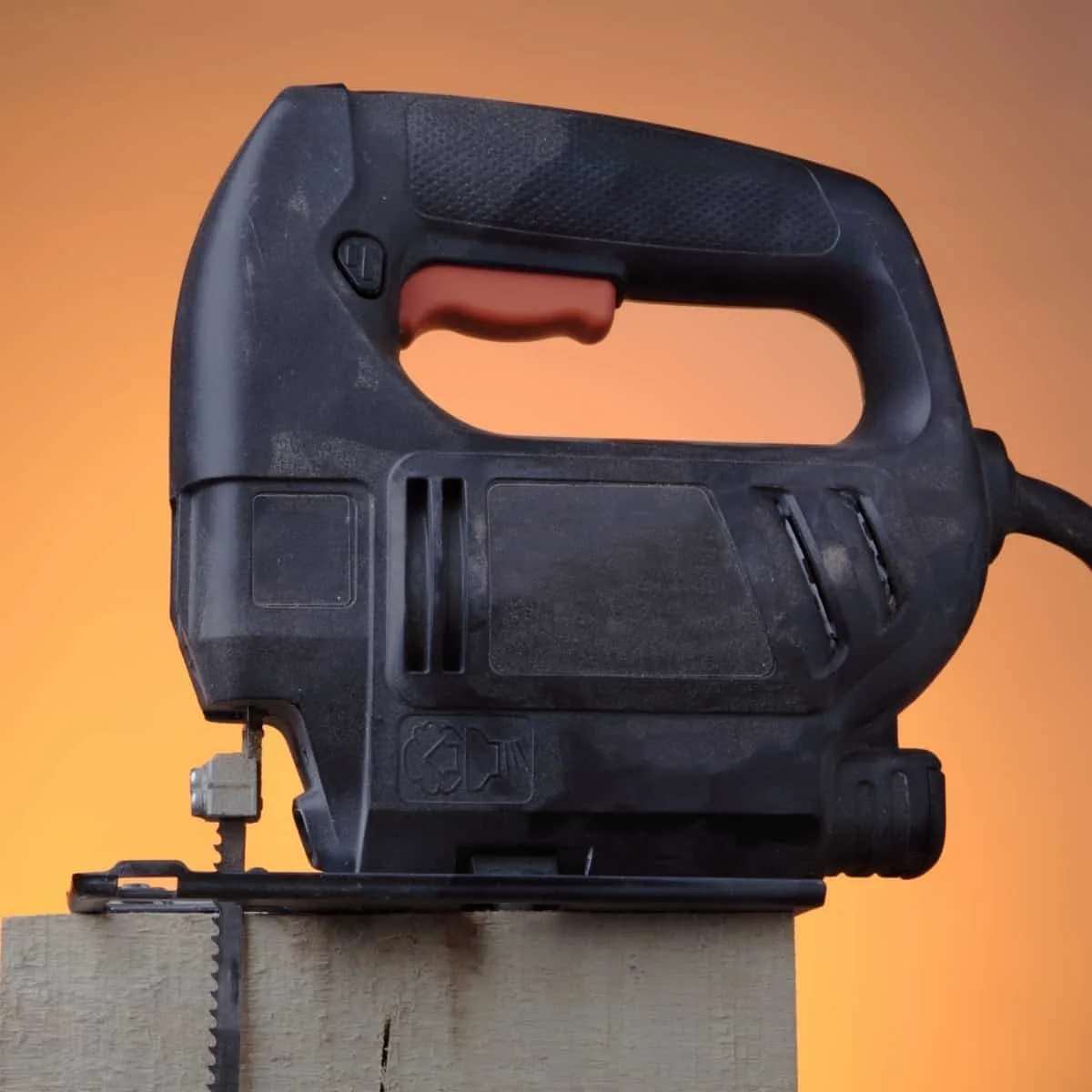
Barrel grip jigsaws are a more recent invention. They have two grip points instead of handles. One is fabricated into the body of the saw with another protruding above the blade. It is usually easier to get more accurate cuts with a barrel grip saw since they are specially designed to be used with both hands.
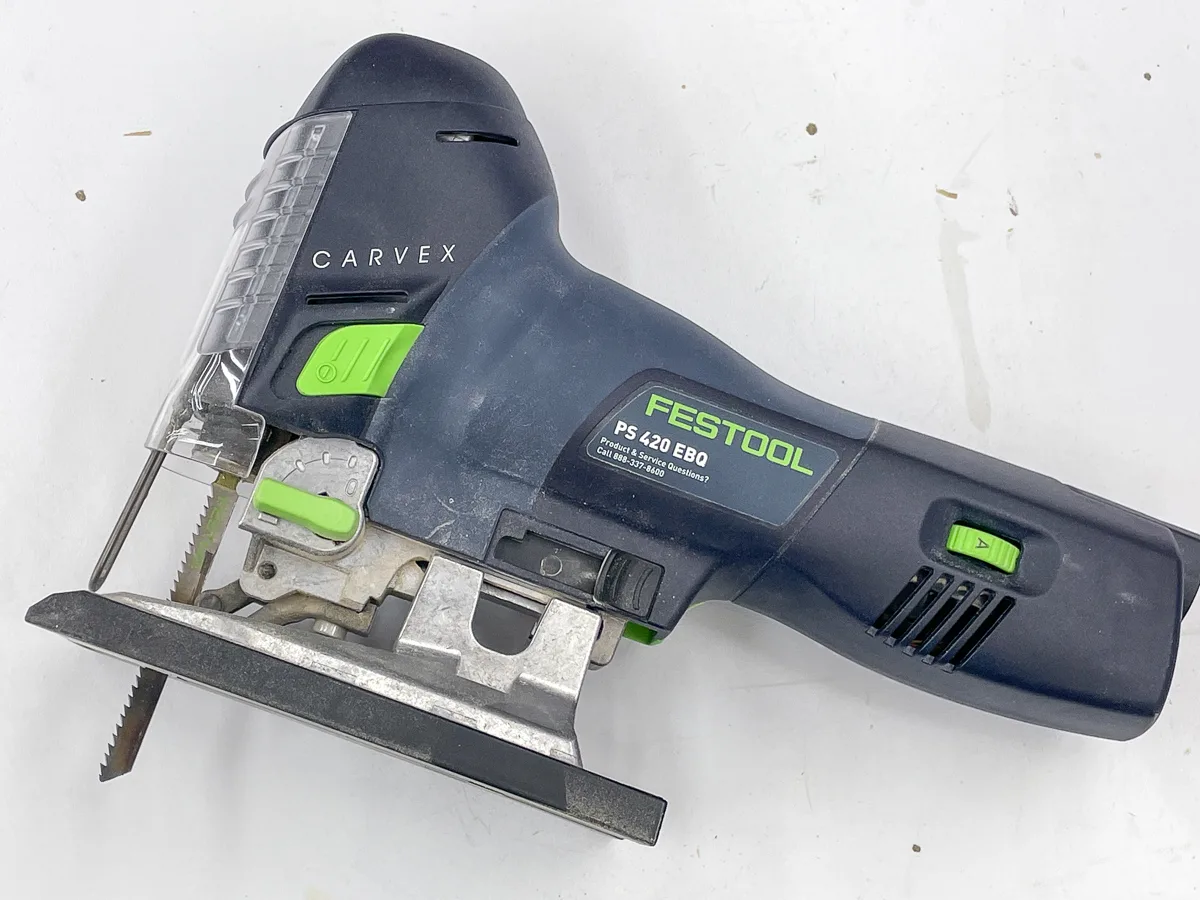
Trigger
This is the switch that turns the saw on. On a D handle style jigsaw, you need to press and hold the trigger underneath the handle as you make the cut to keep the blade moving. On a barrel style jigsaw, there's a switch that turns the blade on, so you don't have to hold the trigger down throughout the entire cut.
Trigger Lock
Some jigsaws have a small button or switch next to the trigger. It enables you to lock the trigger in the "ON" position. This can come in handy when you are cutting a lot of material, because your finger may get tired and sore from holding the trigger down.
Speed Control Dial
This feature allows you to adjust the speed of the blade to get the best results on a variety of materials. No matter how far you pull the trigger, the blade will only go as fast as the setting on the dial.
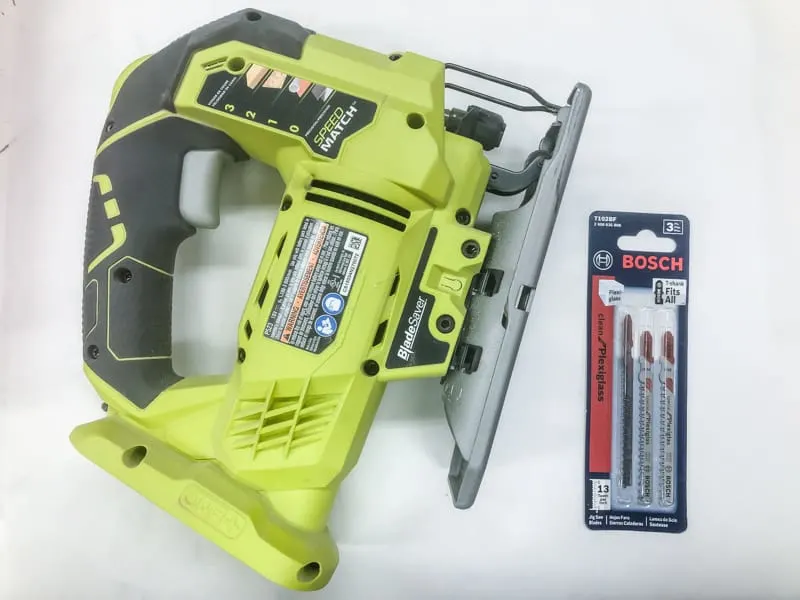
When you are cutting fragile pieces such as acrylic or plexiglass, the speed at which you are cutting is critical. It can be stressful to try and maintain that speed while you are paying attention to everything else about the cut. Using the variable speed dial, you can ensure that you will go the right speed with the trigger fully depressed.
Orbital Action Switch
If you have an orbital jigsaw, the blade not only goes up and down but can also go forward and back. Not all models have this feature, or it could be built into specific speed settings instead of a separate switch.
The orbital setting is great for cutting quickly, but not so great if you are cutting more detailed work. DO NOT use it when you are cutting tile and other brittle material, or you will break it. Many saws have different degrees for this setting, allowing you to adjust it more precisely.
Footplate or Shoe
The footplate or shoe slides along your material and supports the saw as you are cutting. It ensures that you keep the saw flat throughout the cut. Most shoes are adjustable so you can tilt the angle for beveled cuts.
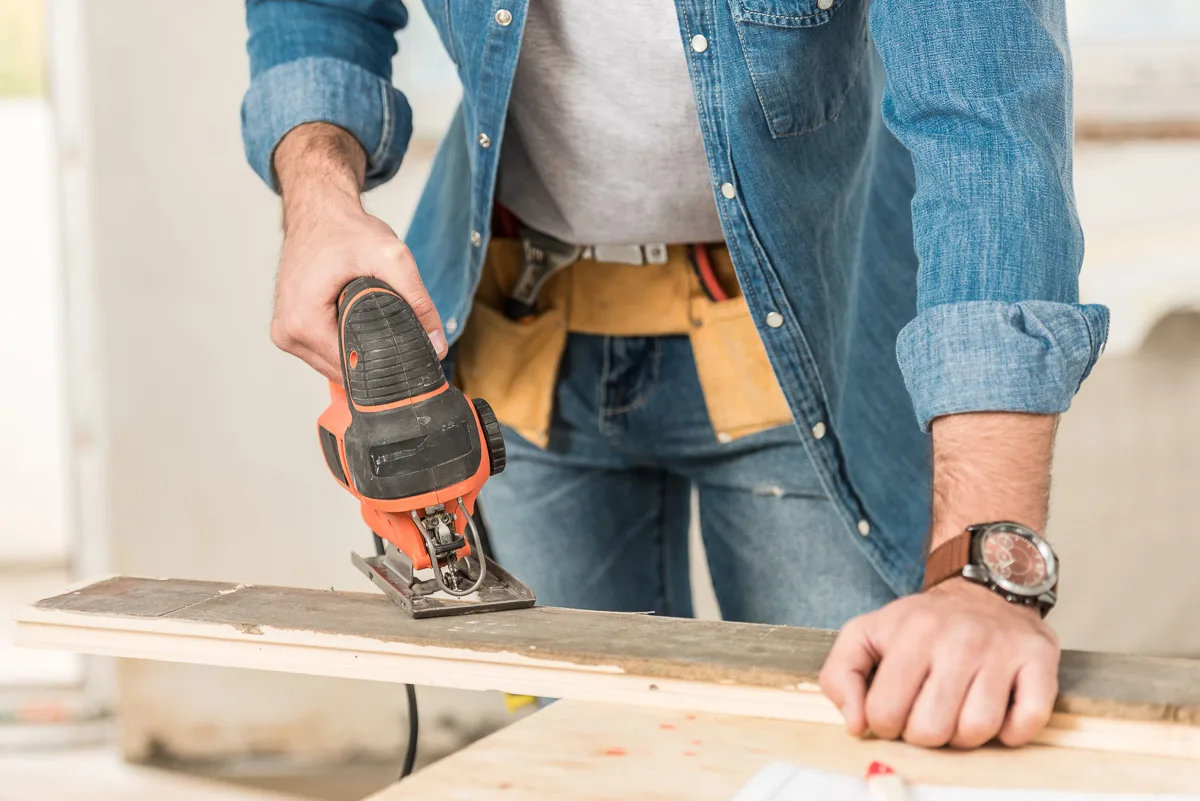
On more recent saw models, there is usually a handy lever that allows you to adjust the angle of the shoe. If there is no quick-release lever, look for a screw or small bolt which you can loosen with the appropriate tool.
Your saw may come with a protective covering for the shoe. This is not meant to protect the shoe; it is intended to protect the material you are cutting. For instance, if you are working with plexiglass, the shoe will easily scratch the surface. You can achieve the same result by applying painter's tape to the bottom!
Blade
There are two different types of jigsaw blades: U-shank blades and T-shank blades. The "U" and the "T" refer to how the blade locks into the saw. T shank blades are quicker and easier to install without any tools.
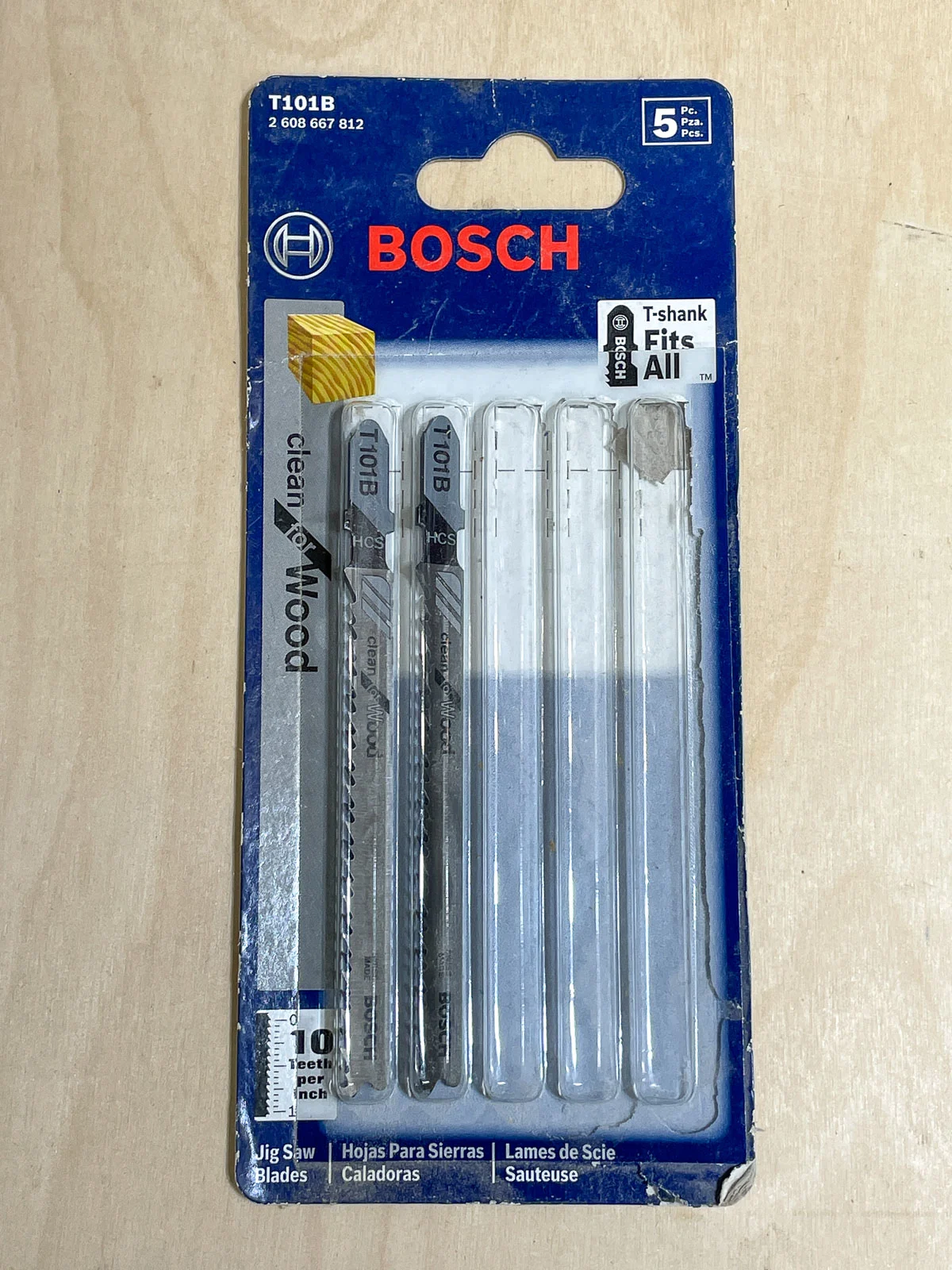
You should always match your blade to the specific type of material you are cutting. You can find blades that are meant for cutting wood, plastic, plexiglass, tile and more! The recommended material will be listed somewhere on the package.
How to Change a Jigsaw Blade
The process for how to change a jigsaw blade varies slightly from saw to saw. The part of the blade which is inserted into the blade clamp is called the shank. There will be a little button or lever which will release the blade from the clamp.
For some models, you twist the blade clamp to release the blade, then hold it in that position to insert the new one. Make sure that the teeth are facing towards the front!
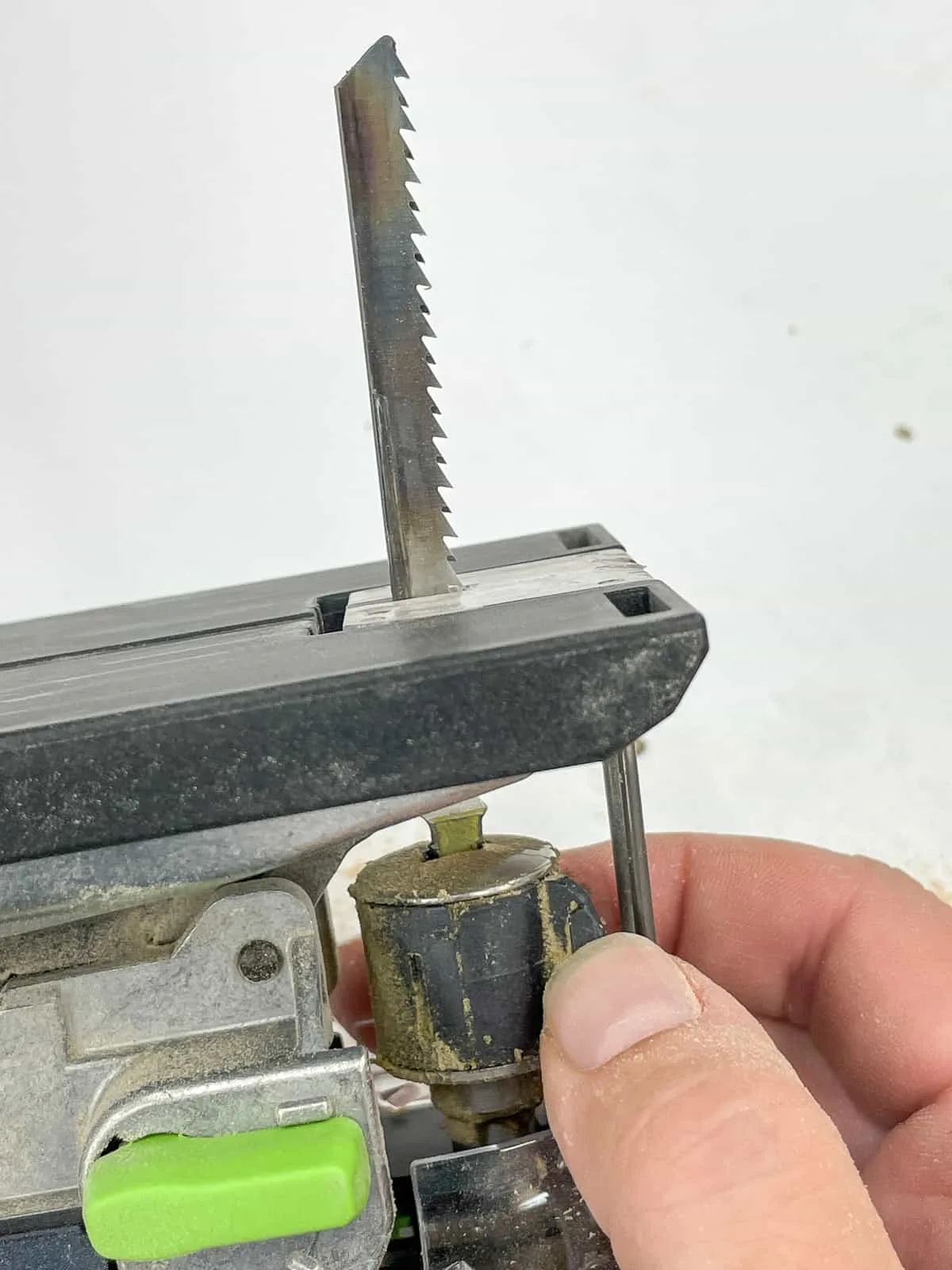
You should reference your saw's user manual for specific blade change instructions. If you don't have the manual anymore, you can probably find it online in PDF form. Just Google your model number to find the right one!
How to Use a Jigsaw
The jigsaw is super easy to use, making it a great option for beginners! Let's over the steps you need to take to make your first cut.
Secure the Board
The first thing you will want to do is to clamp your board down. The movement of the jigsaw blade will cause the board to vibrate, and if it's not clamped down, it could start bouncing around. This makes it much more difficult to get an accurate cut, and could lead to injury.
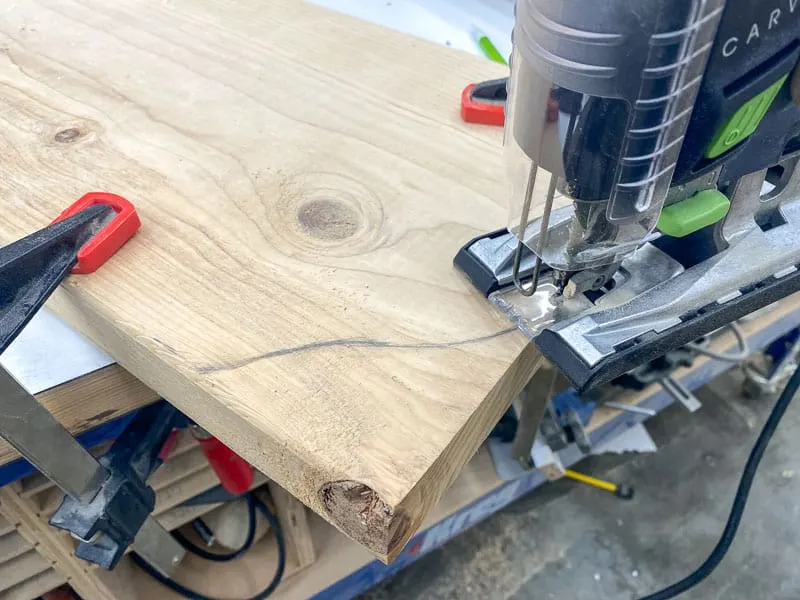
Also, remember to leave space underneath your piece so that there is room for the blade to move. Otherwise, you might break your blade or cut into something you don't mean to. If the cut is at the end of the board or along the edge, you can just hang it over the edge.
But if your project is too big to hang over the edge, you have a few options. One thing you can do is put a bunch of wood blocks on a workbench or table, then place your piece on top of the blocks. I use these anti-skid risers on my t-track table to elevate the workpiece.
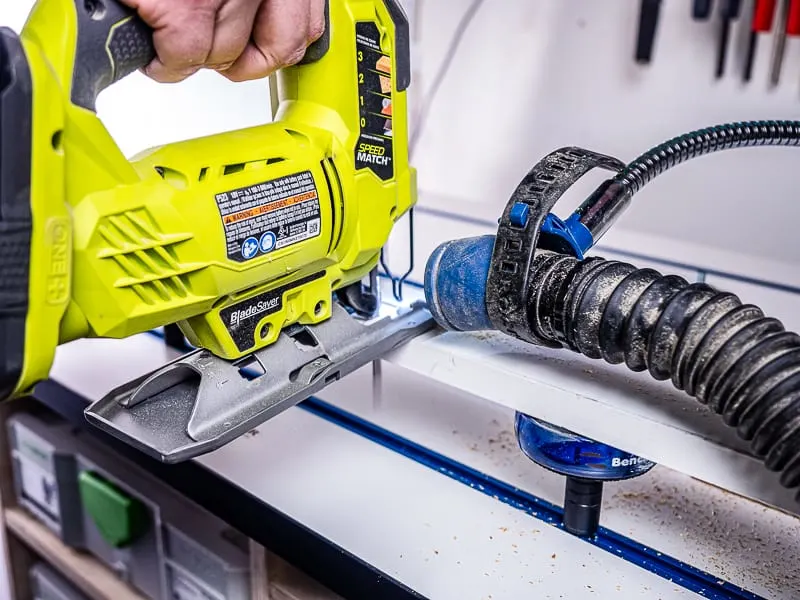
You can also use a thick piece of foam insulation to support the work piece throughout the cut. I keep a 2'x4' sheet of 2" foam board in my workshop just for this purpose! You can cut into it hundreds of times before it needs replacing (so long as you don't cut all the way through!)
Insert the Battery or Plug in the Saw
You'll get the best results with a fully charged battery, so make sure yours are ready to go! If you're using a corded saw, plug it in and check that you have enough cord length to make the entire cut without yanking it out of the wall.
Make the Cut
After you have your piece secured, place the front of the shoe on the edge of your material. Start the saw with the blade off the material, then slowly bring the blade to the edge and begin your cut.
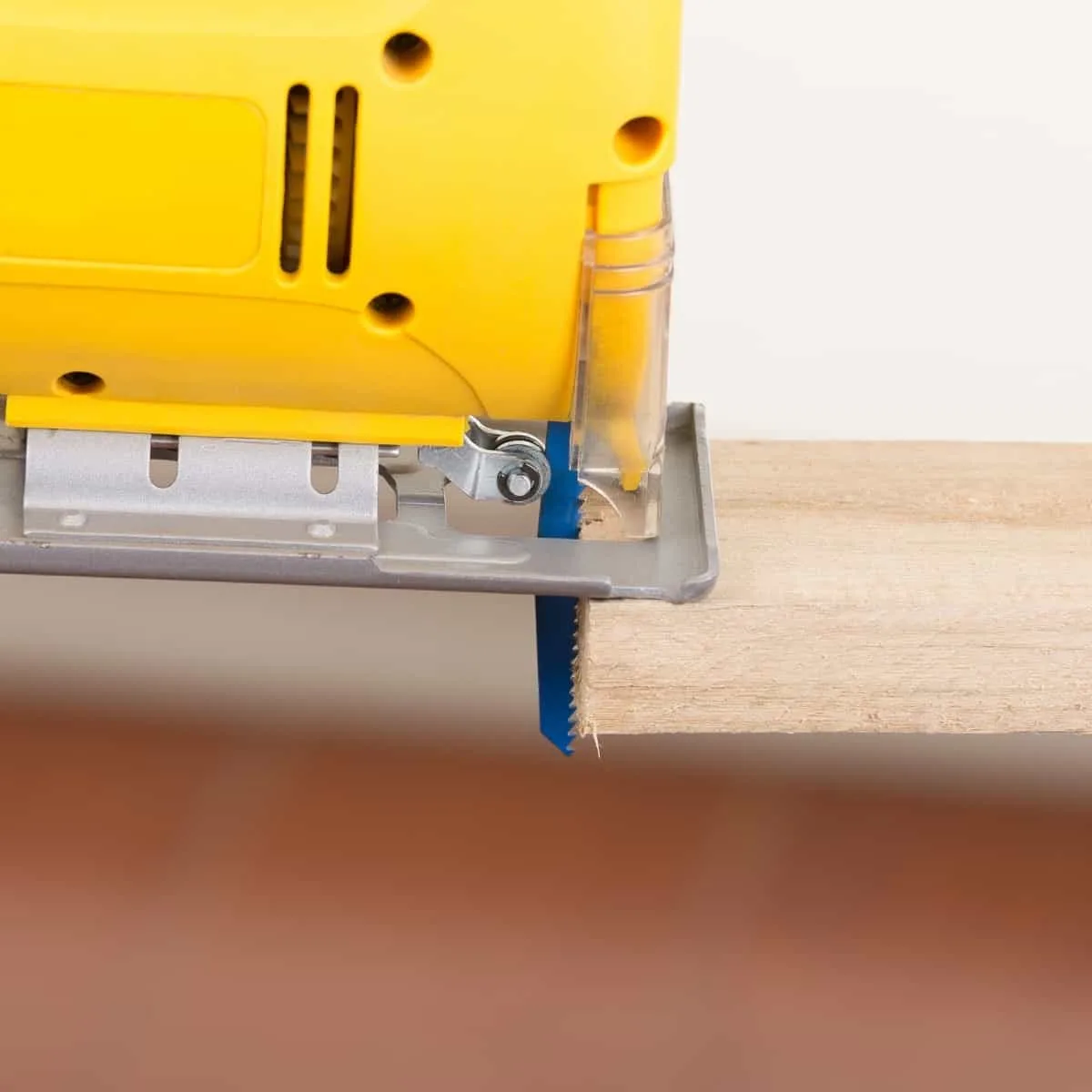
Never follow the middle of your line as you are cutting. You will achieve a much more accurate cut if you choose one edge of your line and follow that instead.
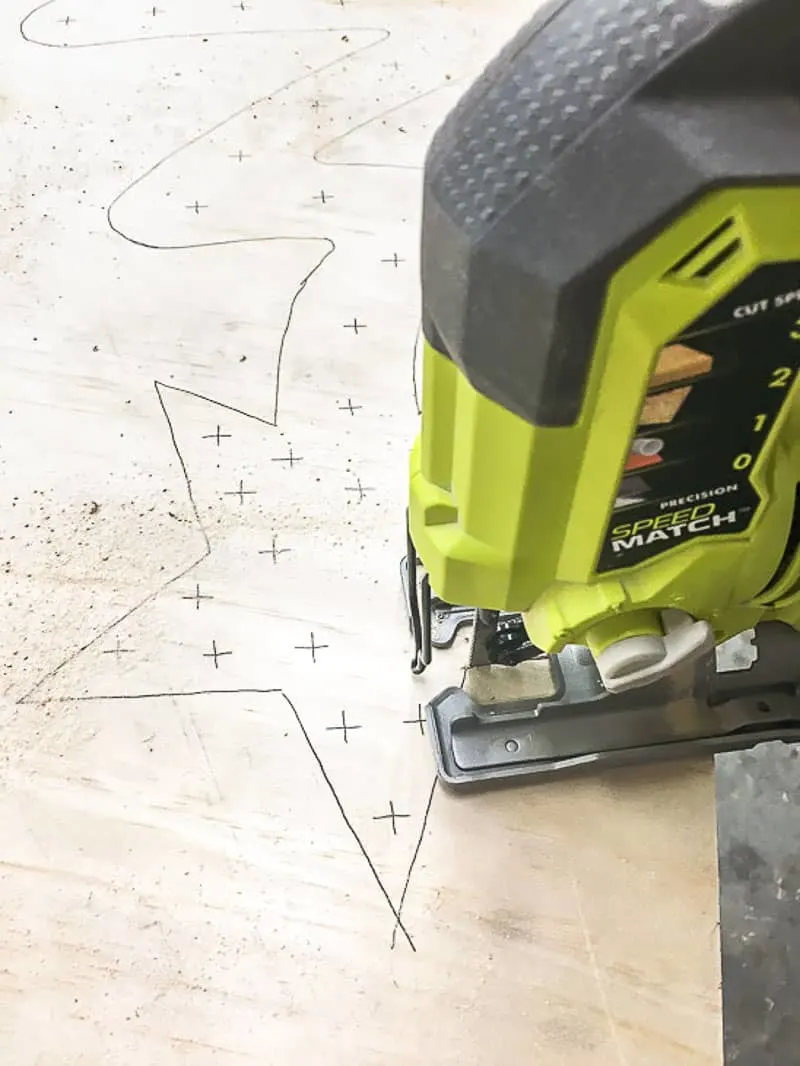
If the end of your cut is on the edge of your piece, you can simply push through to complete it. However, if the cut ends in the middle of your material like in the photo above, stop and take your finger off the trigger.
Let the saw come to a complete stop before lifting the blade out of the wood. Otherwise, the blade may catch in the material and buck back at you. When you're finished with your project, unplug the saw or remove the battery.
How to Cut Curves with a Jigsaw
If you are cutting along a curved line, make sure the radius isn't too tight for the blade. Jigsaws are very flexible, but you can't just twist and turn anyway you want. If the curve is too tight, the saw may buck up and out of the wood, or the blade may snap.
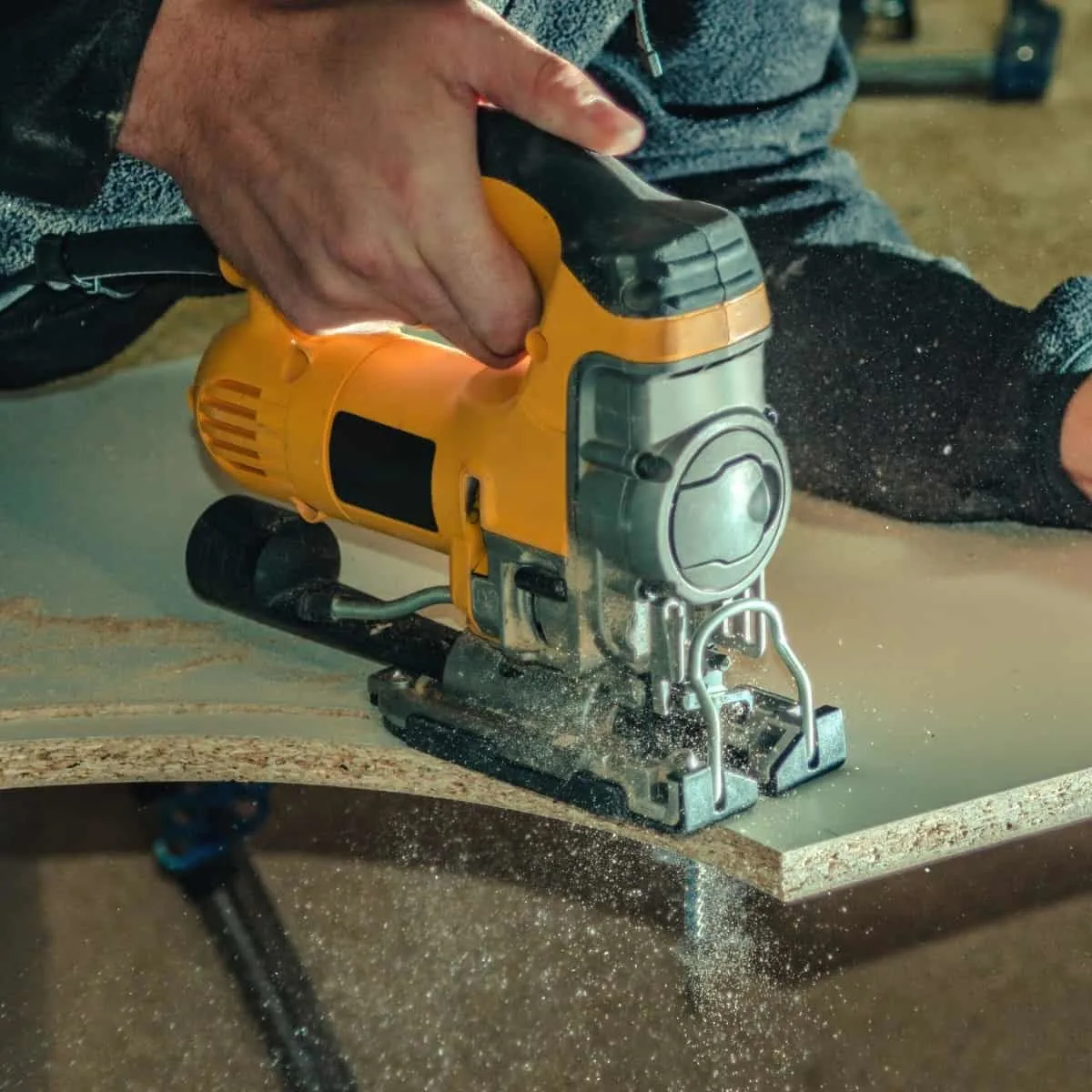
If you need to cut a curve that is too tight for the saw, you can use this trick. First, make a rough cut away from the line to remove the bulk of the material.
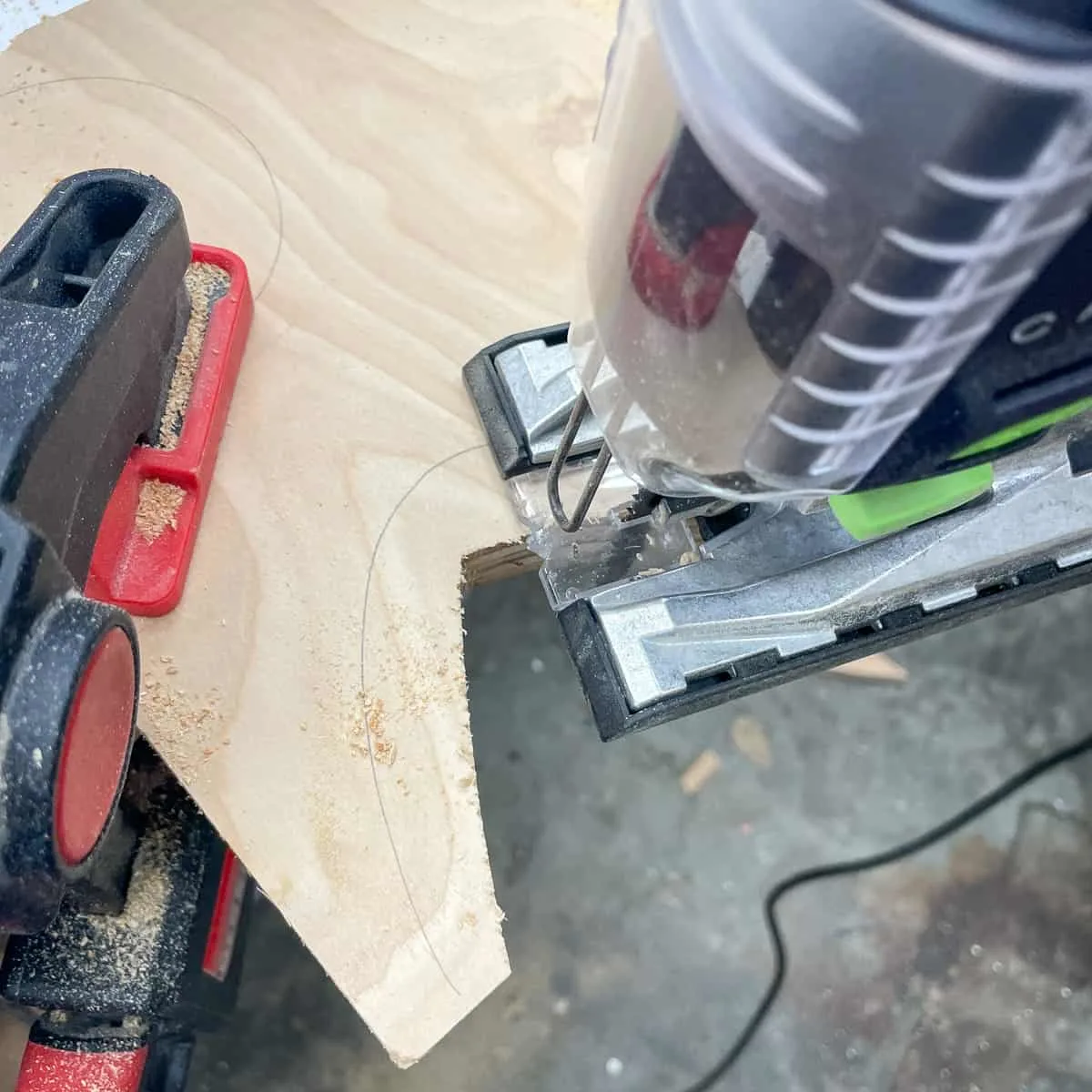
Then make a bunch of little relief cuts at an angle, stopping at your cut line. Once you remove enough material to fit the blade in the gap, you can finish the cut along the line.
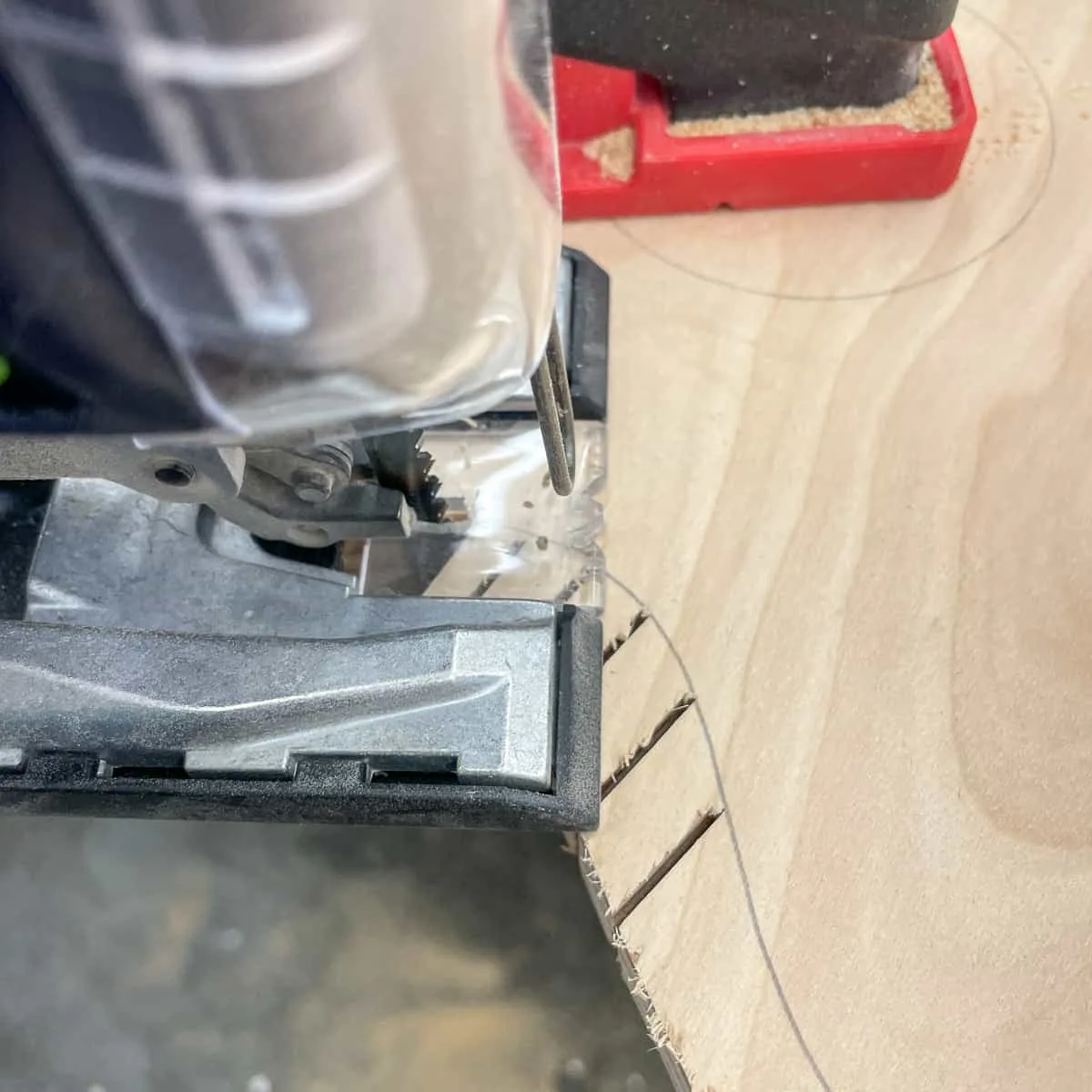
How to Cut Straight Lines with a Jigsaw
Since the principal purpose of the jigsaw is to cut curved lines, keeping it straight can actually be quite tricky. The flexible blade makes it difficult to get clean, straight lines.
Most other saws, such as a circular saw, will do a much better job. You can learn more about the difference between a jigsaw vs a circular saw here!
However, if the jigsaw is all you have, straight cuts can be achieved with a little help from a straight edge guide. You can buy one, or make one similar to this circular saw cutting jig that's customized to your jigsaw. But for a shorter cut, all you'll really need is a speed square!
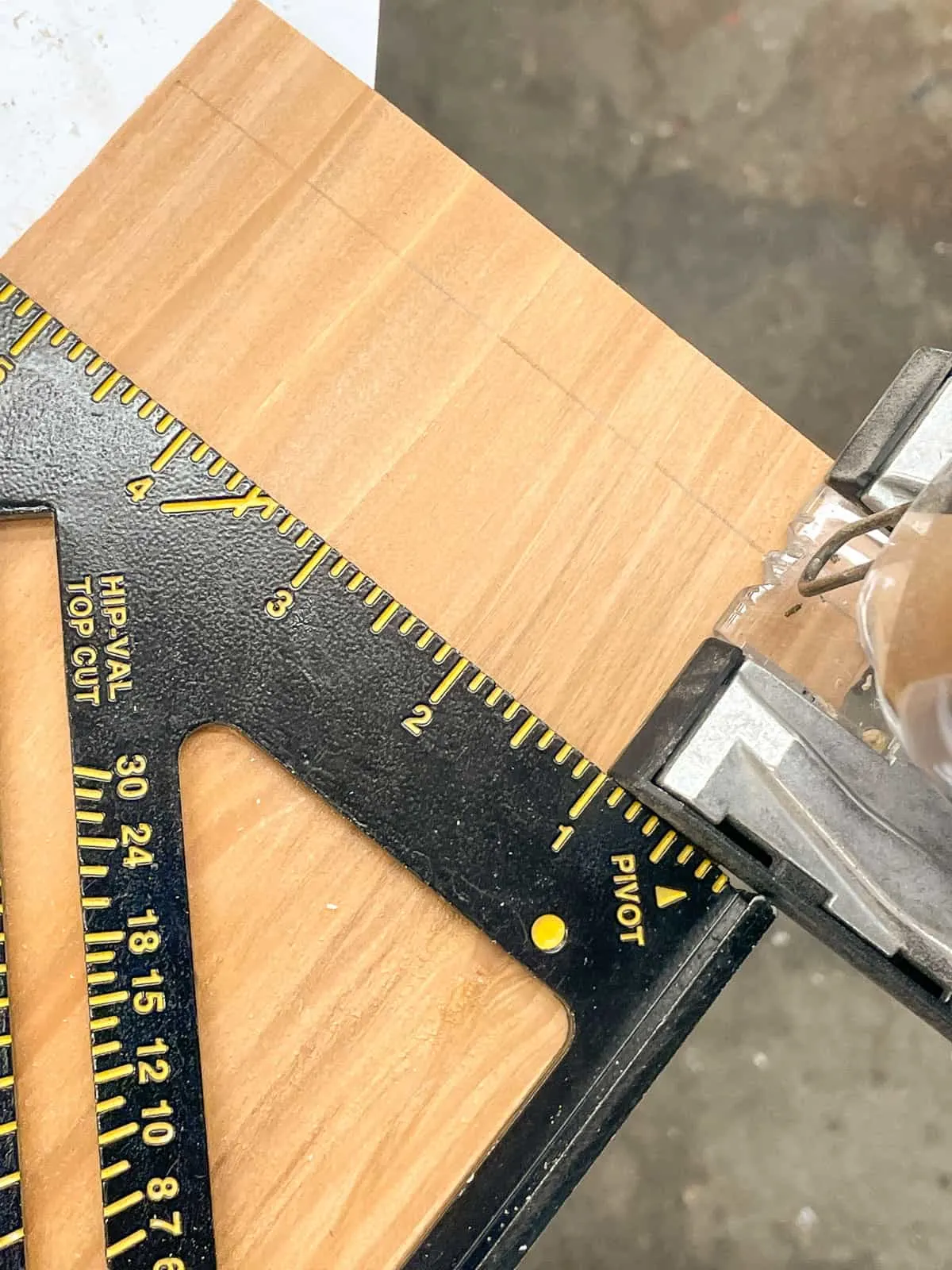
Speed squares have a lip on one side of them, which you can use to make sure that the cut is square to the edge. Align the jigsaw blade with your cut line, and butt the square up next to the side of the shoe. Then you can hold the square in place with one hand and make the cut with the other.
If the cut needs to be more precise or you don't want to worry about it shifting, you can clamp the square in place and make the cut with both hands.
How to Cut Out a Hole with a Jigsaw
Cutting a hole is just like any other cut except for the first step. To start your cut, first drill a hole large enough to fit your jigsaw blade near the cut line inside the hole you want to cut.
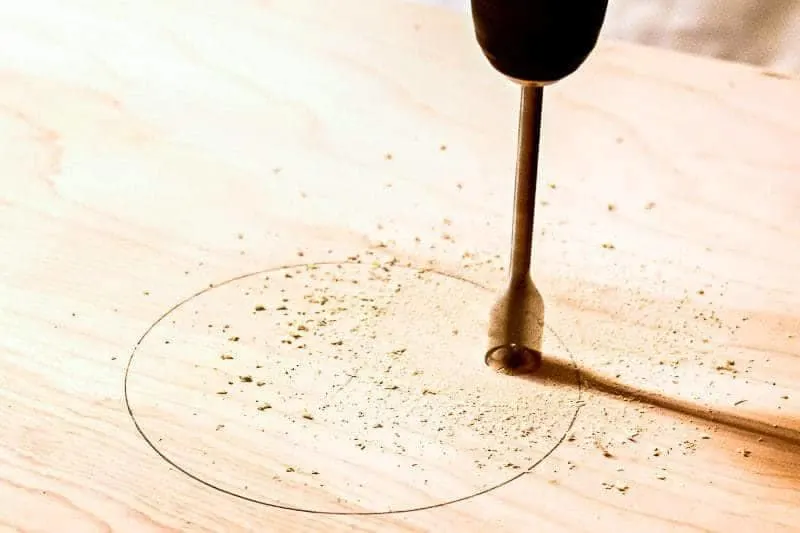
Then use this to put your blade through and start cutting. Don't make your hole too close to the line. Your drill bit may drift as you start and damage the material outside the line. You can always cut away more, but you can't put it back on!
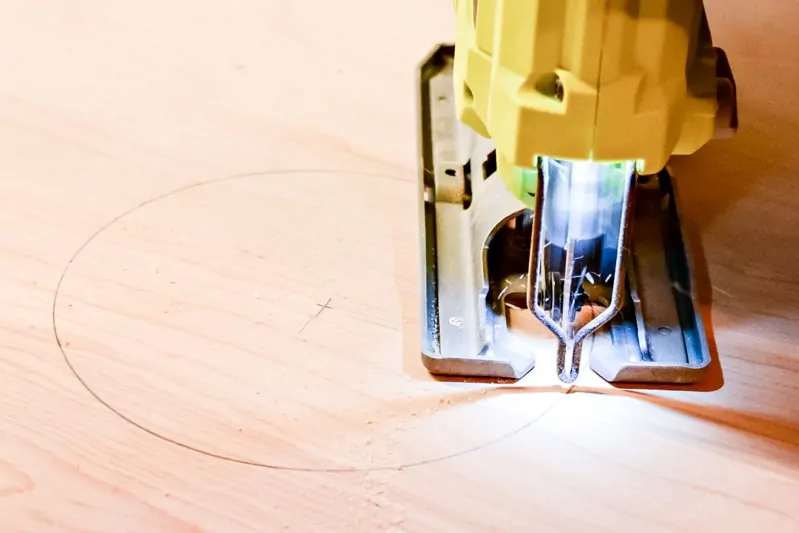
How to Cut a Bevel with a Jigsaw
Cutting beveled angles with a jigsaw is another thing that can be a little tricky, but it is possible. This type of cut is most common when installing trim, or to make a French cleat. Keep in mind that the flexible nature of the blade will create a cut that's not a perfect 45 degree angle, but sometimes you work with what you've got!
Adjust the angle of the shoe to your desired bevel. There should be an angle gauge near the knob to help you get in the ballpark. If you're making a 45 degree cut, you can check the accuracy of the angle with a speed square or combination square. It should fit between the blade and the shoe without any gaps.
Make sure that nothing will impede the progress of the blade underneath while you make the cut. Keep in mind that the cutting depth will decrease when you cut at an angle. Use a straight edge guide to keep the saw from wandering during the cut.
How to Avoid Tear Out with a Jigsaw
Tear out is the term for the splinters which occur on one side of the wood when making a cut. Tear out happens because the last little bit of material is pushed out of the way instead of being cut, causing the wood fibers to break off instead of being sliced through.
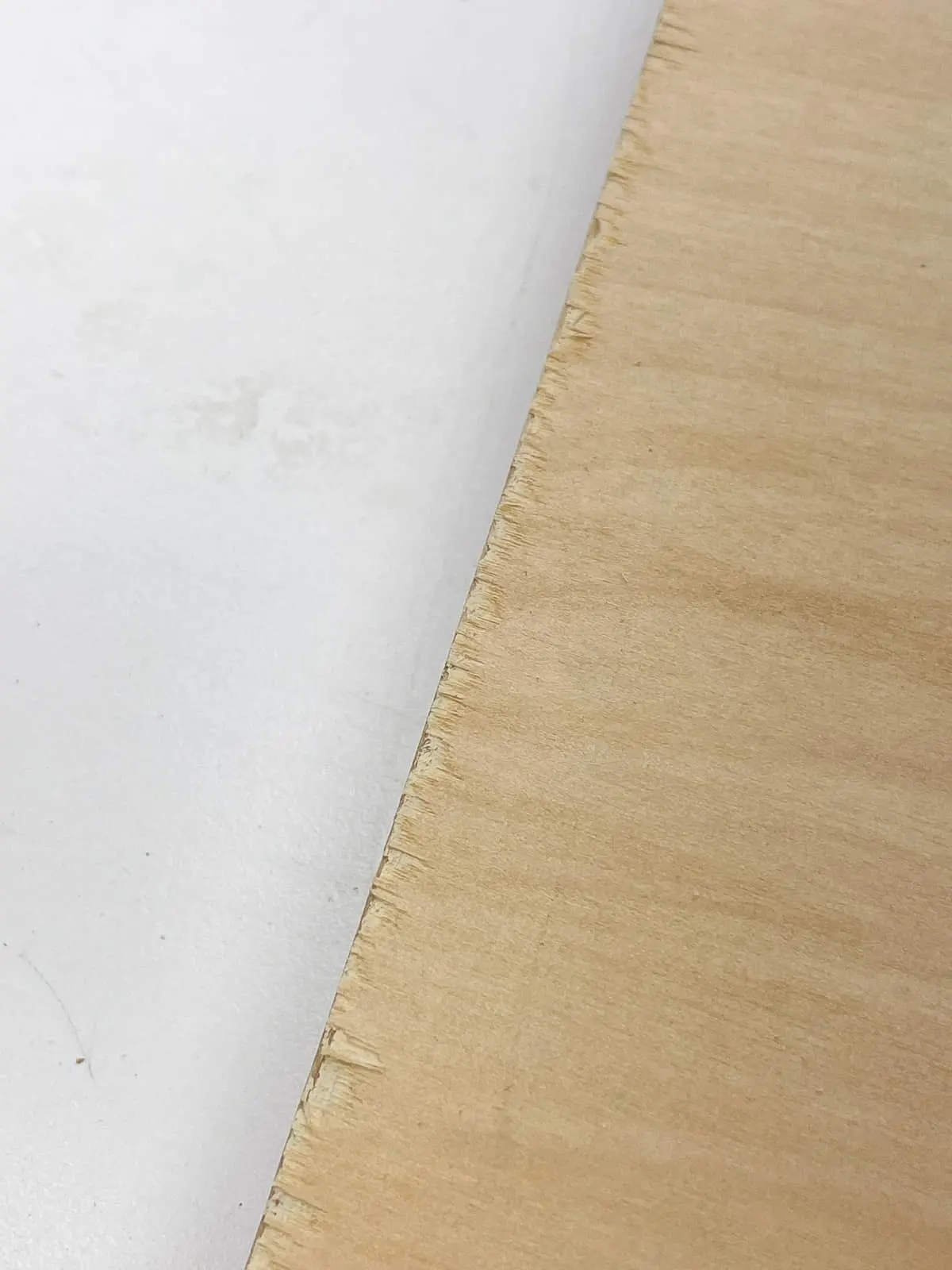
Switch to a Reverse-Tooth Blade
Most jigsaw blades cut on the upstroke, which means that there will be tear out on the top side of the piece. You can try to prevent this from ruining your project by cutting with the "good" side of the board facing down.
If this isn't possible, you can use a reverse-tooth blade, which cuts on the downstroke. For even better results, try a dual cut blade that has teeth going in both directions!
Apply Pressure to the Wood Fibers
Another trick is to use painter's tape to hold the wood fibers in place while you make the cut. This is especially helpful with plywood, which is the most prone to tear out.
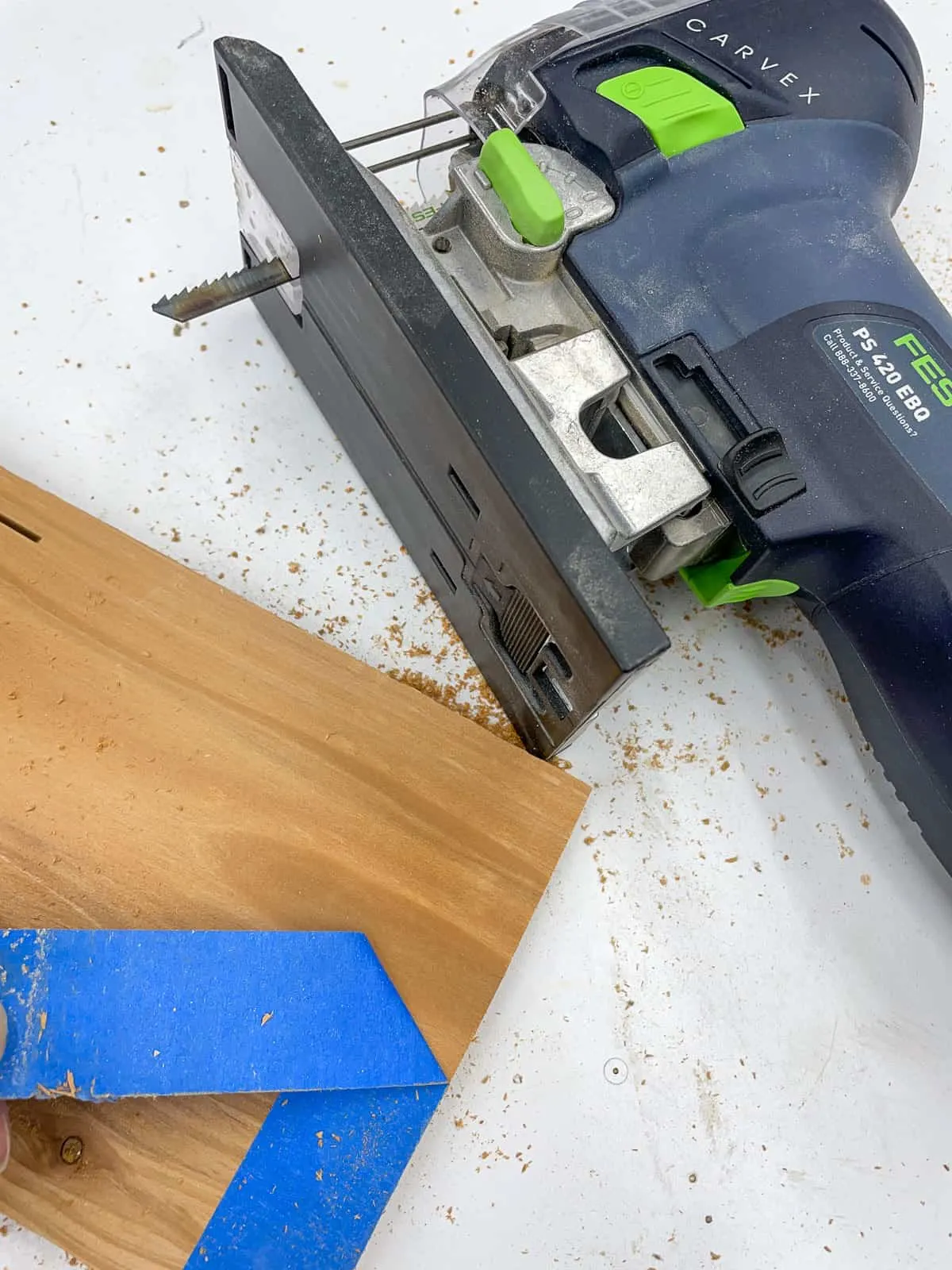
You can combine a reverse-tooth blade with a backer board underneath the cut line to avoid tear out on both sides of the board. A backer board is just a scrap piece of wood clamped to the back of your work piece to hold the wood fibers in place so the blade cuts through them instead of pushing them away.
Frequently Asked Questions about Jigsaws
Why Won't My Jigsaw Cut Straight?
One of the downsides to the jigsaw is difficulty cutting a straight line. You may just need to practice. Cutting a straight line with a jigsaw is a skill. However, you could try a jigsaw guide. These attachments will keep your saw on track.
Can You Cut 2x4s with a Jigsaw?
Yes, but make sure your jigsaw blade extends at least an inch below the wood when fully extended. If you use a blade that is too short, the saw could buck the wood.
Why is My Jigsaw Cutting at an Angle?
The blade may be bent, or you may need to check the angle of your base plate. Ensure your blade is set to a 0-degree angle. Also, remember to keep your base plate flush with the material - this will minimize side-to-side wiggle.
I hope this article answered all your questions about how to use a jigsaw! This versatile tool is easy to use, and is a great first saw for beginning woodworking!
Check out these other beginning woodworking tutorials!
